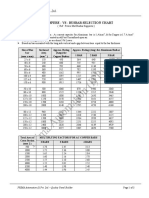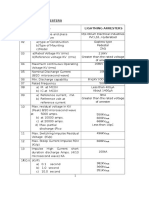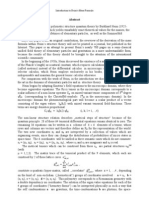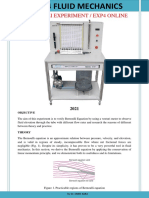0 ratings0% found this document useful (0 votes)
2K viewsHow To Calculate KVAR
How To Calculate KVAR
Uploaded by
umair_aeThe document provides examples and step-by-step solutions for calculating the suitable capacitor size in kVAR and Farads needed to improve power factor in single phase and three phase circuits. It explains how to determine the required capacitor value using simple table methods or classical calculation methods involving power, voltage, current, and power factor values. Formulas for capacitive reactance, apparent power, reactive power and other electrical relationships are also defined to further aid in power factor correction calculations.
Copyright:
© All Rights Reserved
Available Formats
Download as DOCX, PDF, TXT or read online from Scribd
How To Calculate KVAR
How To Calculate KVAR
Uploaded by
umair_ae0 ratings0% found this document useful (0 votes)
2K views4 pagesThe document provides examples and step-by-step solutions for calculating the suitable capacitor size in kVAR and Farads needed to improve power factor in single phase and three phase circuits. It explains how to determine the required capacitor value using simple table methods or classical calculation methods involving power, voltage, current, and power factor values. Formulas for capacitive reactance, apparent power, reactive power and other electrical relationships are also defined to further aid in power factor correction calculations.
Original Description:
A useful document to calculate the KVAR for PFI Plants.
Original Title
How to Calculate KVAR
Copyright
© © All Rights Reserved
Available Formats
DOCX, PDF, TXT or read online from Scribd
Share this document
Did you find this document useful?
Is this content inappropriate?
The document provides examples and step-by-step solutions for calculating the suitable capacitor size in kVAR and Farads needed to improve power factor in single phase and three phase circuits. It explains how to determine the required capacitor value using simple table methods or classical calculation methods involving power, voltage, current, and power factor values. Formulas for capacitive reactance, apparent power, reactive power and other electrical relationships are also defined to further aid in power factor correction calculations.
Copyright:
© All Rights Reserved
Available Formats
Download as DOCX, PDF, TXT or read online from Scribd
Download as docx, pdf, or txt
0 ratings0% found this document useful (0 votes)
2K views4 pagesHow To Calculate KVAR
How To Calculate KVAR
Uploaded by
umair_aeThe document provides examples and step-by-step solutions for calculating the suitable capacitor size in kVAR and Farads needed to improve power factor in single phase and three phase circuits. It explains how to determine the required capacitor value using simple table methods or classical calculation methods involving power, voltage, current, and power factor values. Formulas for capacitive reactance, apparent power, reactive power and other electrical relationships are also defined to further aid in power factor correction calculations.
Copyright:
© All Rights Reserved
Available Formats
Download as DOCX, PDF, TXT or read online from Scribd
Download as docx, pdf, or txt
You are on page 1of 4
At a glance
Powered by AI
The key takeaways are methods to calculate capacitor size needed to improve power factor using table lookup or classical calculation, as well as how to convert between kVAR and Farads units.
You can use a simple table lookup method or classical calculation method involving tangent functions to determine the required capacitor size in kVAR needed to improve the power factor between two known values.
You can convert between capacitor size in kVAR and Farads using the formula C = kVAR / (2 * π * f * V^2) where C is in microfarads, f is frequency and V is voltage.
How to Calculate the Suitable Capacitor Size in Farads & kVAR
for Power factor Improvement (Easiest way ever)
How to Calculate the Suitable Capacitor Size in Farads & kVAR for Power factor
Improvement (Easiest way ever)
Hi there! With a very important tutorial.. I hope you will find it very useful because I have already spent
two days to prepare this article. I think all of those who have sent messages and mails about the topic
will never ask again if they follow these simple methods to calculate the proper Size of Capacitor bank in
kVAR and micro-farads for power factor correction and improvement in both single phase and three
phase circuits. I think its too much..
Now lets begin...
Consider the following Examples.
Example: 1
A 3 Phase, 5 kW Induction Motor has a P.F (Power factor) of 0.75 lagging. What size of Capacitor
in kVAR is required to improve the P.F (Power Factor) to 0.90?
Solution #1 (By Simple Table Method)
Motor Input = 5kW
From Table, Multiplier to improve PF from 0.75 to 0.90 is .398
Required Capacitor kVAR to improve P.F from 0.75 to 0.90
Required Capacitor kVAR = kW x Table 1 Multiplier of 0.75 and 0.90
= 5kW x .398
= 1.99 kVAR
And Rating of Capacitors connected in each Phase
1.99/3 = 0.663 kVAR
Solution # 2 (Classical Calculation Method)
Motor input = P = 5 kW
Original P.F = Cos1 = 0.75
Final P.F = Cos2 = 0.90
1 = Cos
-1
= (0.75) = 41.41; Tan 1 = Tan (41.41) = 0.8819
2 = Cos
-1
= (0.90) = 25.84; Tan 2 = Tan (25.50) = 0.4843
Required Capacitor kVAR to improve P.F from 0.75 to 0.90
Required Capacitor kVAR = P (Tan 1 - Tan 2)
= 5kW (0.8819 0.4843)
= 1.99 kVAR
And Rating of Capacitors connected in each Phase
1.99/3 = 0.663 kVAR
Example 2:
An Alternator is supplying a load of 650 kW at a P.F (Power factor) of 0.65. What size of Capacitor
in kVAR is required to raise the P.F (Power Factor) to unity (1)? And how many more kW can the
alternator supply for the same kVA loading when P.F improved.
Solution #1 (By Simple Table Method)
Supplying kW = 650 kW
From Table 1, Multiplier to improve PF from 0.65 to unity (1) is 1.169
Required Capacitor kVAR to improve P.F from 0.65 to unity (1)
Required Capacitor kVAR = kW x Table 1 Multiplier of 65 and 100
= 650kW x 1.169
= 759.85 kVAR
We know that P.F = Cos = kW/kVA . . .or
kVA = kW / Cos
= 650/0.65 = 1000 kVA
When Power Factor is raised to unity (1)
No of kW = kVA x Cos
= 1000 x 1 = 1000kW
Hence increased Power supplied by Alternator
1000kW 650kW = 350kW
Solution # 2 (Classical Calculation Method)
Supplying kW = 650 kW
Original P.F = Cos1 = 0.65
Final P.F = Cos2 = 1
1 = Cos
-1
= (0.65) = 49.45; Tan 1 = Tan (41.24) = 1.169
2 = Cos
-1
= (1) = 0; Tan 2 = Tan (0) = 0
Required Capacitor kVAR to improve P.F from 0.75 to 0.90
Required Capacitor kVAR = P (Tan 1 - Tan 2)
= 650kW (1.169 0)
= 759.85 kVAR
How to Calculate the Required Capacitor bank value in both kVAR and Farads?
(How to Convert Farads into kVAR and Vice Versa)
Example: 3
A Single phase 400V, 50Hz, motor takes a supply current of 50A at a P.F (Power factor) of 0.6. The
motor power factor has to be improved to 0.9 by connecting a capacitor in parallel with it.
Calculate the required capacity of Capacitor in both kVAR and Farads.
Solution.:
(1) To find the required capacity of Capacitance in kVAR to improve P.F from 0.6 to
0.9 (Two Methods)
Solution #1 (By Simple Table Method)
Motor Input = P = V x I x Cos
= 400V x 50A x 0.6
= 12kW
From Table, Multiplier to improve PF from 0.60 to 0.90 is 0.849
Required Capacitor kVAR to improve P.F from 0.60 to 0.90
Required Capacitor kVAR = kW x Table Multiplier of 0.60 and 0.90
= 12kW x 0.849
= 10.188 kVAR
Solution # 2 (Classical Calculation Method)
Motor Input = P = V x I x Cos
= 400V x 50A x 0.6
= 12kW
Actual P.F = Cos1 = 0..6
Required P.F = Cos2 = 0.90
1 = Cos
-1
= (0.60) = 53.13; Tan 1 = Tan (53.13) = 1.3333
2 = Cos
-1
= (0.90) = 25.84; Tan 2 = Tan (25.50) = 0.4843
Required Capacitor kVAR to improve P.F from 0.60 to 0.90
Required Capacitor kVAR = P (Tan 1 - Tan 2)
= 5kW (1.3333 0.4843)
= 10.188 kVAR
(2) To find the required capacity of Capacitance in Farads to improve P.F from 0.6 to
0.9 (Two Methods)
Solution #1 (Using a Simple Formula)
We have already calculated the required Capacity of Capacitor in kVAR, so we can easily convert it into
Farads by using this simple formula
Required Capacity of Capacitor in Farads/Microfarads
C = kVAR / (2 f V
2
) in microfarad
Putting the Values in the above formula
= (10.188kVAR) / (2 x x 50 x 400
2
)
= 2.0268 x 10
-4
= 202.7 x 10
-6
= 202.7F
Solution # 2 (Simple Calculation Method)
kVAR = 10.188 (i)
We know that;
IC = V/ XC
Whereas XC = 1 / 2 F C
IC = V / (1 / 2 F C)
IC = V 2 F C
= (400) x 2 x (50) x C
IC = 125663.7 x C
And,
kVAR = (V x IC) / 1000 [kVAR =( V x I)/ 1000 ]
= 400 x 125663.7 x C
IC = 50265.48 x C (ii)
Equating Equation (i) & (ii), we get,
50265.48 x C = 10.188C
C = 10.188 / 50265.48
C = 2.0268 x 10
-4
C = 202.7 x 10
-6
C = 202.7F
Example 4
What value of Capacitance must be connected in parallel with a load drawing 1kW at 70% lagging
power factor from a 208V, 60Hz Source in order to raise the overall power factor to 91%.
Solution:
You can use either Table method or Simple Calculation method to find the required value of Capacitance
in Farads or kVAR to improve Power factor from 0.71 to 0.97. So I used table method in this case.
P = 1000W
Actual Power factor = Cos1 = 0.71
Desired Power factor = Cos2 = 0.97
From Table, Multiplier to improve PF from 0.71 to 0.97 is 0.783
Required Capacitor kVAR to improve P.F from 0.71 to 0.97
Required Capacitor kVAR = kW x Table Multiplier of 0.71 and 0.97
= 1kW x 0.783
=783 VAR (required Capacitance Value in kVAR)
Current in the Capacitor =
IC = QC / V
= 783 / 208
= 3.76A
And
XC = V / IC
= 208 / 3.76 = 55.25
C = 1/ (2 f XC)
C = 1 (2 x 60 x 55.25)
C = 48 F (required Capacitance Value in Farads)
Good to Know:
Important formulas which is used for Power factor improvement calculation as well
as used in the above calculation
Power in Watts
kW = kVA x Cos
kW = HP x 0.746 or (HP x 0.746) / Efficiency (HP = Motor Power)
kW = ( kVA
2
- kVAR
2
)
kW = P = VI Cos (Single Phase)
kW = P =3x V x I Cos (Three Phase)
Apparent Power in VA
kVA= (kW
2
+ kVAR
2
)
kVA = kW/ Cos
Reactive Power in VA
kVAR= (kVA
2
- kW
2
)
kVAR = C x (2 f V
2
)
Power factor (from 0.1 to 1)
Power Factor = Cos = P / V I (Single Phase)
Power Factor = Cos = P / (3x V x I) (Three Phase)
Power Factor = Cos = kW / kVA (Both Single Phase & Three Phase)
Power Factor = Cos = R/Z (Resistance / Impedance)
XC = 1/ (2 f C) (XC = Capacitive reactance)
IC = V/ XC (I = V / R)
Required Capacity of Capacitor in Farads/Microfarads
C = kVAR / (2 f V
2
) in microfarad
Required Capacity of Capacitor in kVAR
kVAR = C x (2 f V
2
)
You might also like
- AC Choke CalculationDocument2 pagesAC Choke CalculationSri Varshini100% (1)
- Porject Submitted By-: Project MentorDocument37 pagesPorject Submitted By-: Project MentorPritam100% (2)
- Basics of Motor Starting StudyDocument18 pagesBasics of Motor Starting StudyJerome Eugene100% (1)
- Electrical Engineering Portal Com Electrical Thumb Rules You Must Follow Part 1Document10 pagesElectrical Engineering Portal Com Electrical Thumb Rules You Must Follow Part 1m kh0% (1)
- Short Circuit Current CalculationDocument5 pagesShort Circuit Current CalculationDheeraj Yadav100% (1)
- 3 Phase CalculationDocument7 pages3 Phase Calculationardin0506No ratings yet
- Lesson Plan For Currency UnitDocument5 pagesLesson Plan For Currency Unitapi-280607295No ratings yet
- Capacitor Bank Calculation ExampleDocument12 pagesCapacitor Bank Calculation Exampleqwerty uiop100% (2)
- How To Calculate The Suitable Capacitor Size in Farads & kVAR For Power Factor Improvement (Easiest Way Ever) - Electrical Technology PDFDocument6 pagesHow To Calculate The Suitable Capacitor Size in Farads & kVAR For Power Factor Improvement (Easiest Way Ever) - Electrical Technology PDFjabranaliNo ratings yet
- Calculate Size of Capacitor BankDocument5 pagesCalculate Size of Capacitor BankMedyouNo ratings yet
- Busbar Size and CalculationDocument5 pagesBusbar Size and Calculationphyo7799No ratings yet
- (Fcma) Flux Controlled Magnetic Amplifier Reactor Type Harmonic Free H.T.Soft StartersDocument6 pages(Fcma) Flux Controlled Magnetic Amplifier Reactor Type Harmonic Free H.T.Soft Startersmv_mallik100% (1)
- Transformer 10028 - 1 PDFDocument15 pagesTransformer 10028 - 1 PDFAman Deep100% (1)
- Short Circuit Current Calculation (Base KVA Method) - Electrical Notes & ArticlesDocument4 pagesShort Circuit Current Calculation (Base KVA Method) - Electrical Notes & ArticlesSrikanth Bhatt100% (1)
- 11 KV VCB With 1250A IC OG 6 Panel Board - FinalDocument16 pages11 KV VCB With 1250A IC OG 6 Panel Board - FinalAbhinav TewariNo ratings yet
- Important NumericalsDocument1 pageImportant NumericalscheshankarNo ratings yet
- MOTOR SOFT STARTERS - Air Core ReactorsDocument3 pagesMOTOR SOFT STARTERS - Air Core Reactorsmv_mallikNo ratings yet
- Useful Electrical OperationsDocument53 pagesUseful Electrical Operationsthegemishere100% (3)
- Voltage Drop Calculation of 11kV H.V. Motor at Starting: ST STDocument2 pagesVoltage Drop Calculation of 11kV H.V. Motor at Starting: ST STdpkfatnani05100% (1)
- Electrical Thumb Rules (Part-2) - Electrical Notes & ArticlesDocument2 pagesElectrical Thumb Rules (Part-2) - Electrical Notes & ArticlesRajj Pruthivi100% (2)
- Installation Planning and EstimatingDocument26 pagesInstallation Planning and EstimatingNoob player Free Fire100% (2)
- 11 KV Planning GuideDocument171 pages11 KV Planning GuideM Qamar NazeerNo ratings yet
- Pick-Up Current, Plug Setting Multiplier (PSM) and Time Setting Multiplier (TSM) - Electrical ConceptsDocument11 pagesPick-Up Current, Plug Setting Multiplier (PSM) and Time Setting Multiplier (TSM) - Electrical ConceptsRanjan RajuNo ratings yet
- Calculate Transformer Size and MotorDocument2 pagesCalculate Transformer Size and MotorThirumalNo ratings yet
- Electrical Equipment SizingDocument4 pagesElectrical Equipment Sizingarshadbaya100% (1)
- Electrical Thumb Rules - (Part 1)Document4 pagesElectrical Thumb Rules - (Part 1)Electrical Radical100% (7)
- Amp Vs Busbar SelectionDocument3 pagesAmp Vs Busbar SelectionPower MuruganNo ratings yet
- Battery Sizing CalculationDocument3 pagesBattery Sizing CalculationDennis DanielNo ratings yet
- Chimney Height Calculation For DG Set RatingsDocument1 pageChimney Height Calculation For DG Set RatingsRenu JainNo ratings yet
- Electrical Thumb Rules-Illumination - (Part-16) - Electrical Notes & ArticlesDocument14 pagesElectrical Thumb Rules-Illumination - (Part-16) - Electrical Notes & ArticlesElectrical Radical100% (3)
- Chapter 6 Power Factor Improvement (Compatibility Mode)Document53 pagesChapter 6 Power Factor Improvement (Compatibility Mode)katlegoNo ratings yet
- Calculation of Multiplication Factor of Energy MetersDocument3 pagesCalculation of Multiplication Factor of Energy Metersimcoolmailme2100% (1)
- Battery Bank CalculationDocument3 pagesBattery Bank CalculationJoshua Cm100% (2)
- 66 KV Substation Getco RanasanDocument7 pages66 KV Substation Getco RanasanDivyanshu Agarwal100% (1)
- MCB - MCCB - ELCB - RCCB - Electrical Notes & ArticlesDocument11 pagesMCB - MCCB - ELCB - RCCB - Electrical Notes & ArticlesLalantha KodikaraNo ratings yet
- Ee-359 Electrical Power Distribution and Utilization:: Complex Engineering Problem TASK# 03Document8 pagesEe-359 Electrical Power Distribution and Utilization:: Complex Engineering Problem TASK# 03akif amirNo ratings yet
- Transformer Losses & EfficencyDocument8 pagesTransformer Losses & EfficencyMuhammad Zumy100% (1)
- How To Read MCB Nameplate RatingDocument4 pagesHow To Read MCB Nameplate RatingfauzNo ratings yet
- Detail Specification of 220 KV Current TransformerDocument4 pagesDetail Specification of 220 KV Current TransformersubratcetbNo ratings yet
- 3.1 Selection of Cross Section of Grid Conductor (A) : 3.0 CalculationDocument5 pages3.1 Selection of Cross Section of Grid Conductor (A) : 3.0 CalculationPrasadNo ratings yet
- Transformer Size For Large Motor StartingDocument5 pagesTransformer Size For Large Motor Startingبنیاد پرست100% (1)
- Getco Fault Level - Sept-2016Document67 pagesGetco Fault Level - Sept-2016jigyeshNo ratings yet
- A Series Tuned Harmonic FilterDocument59 pagesA Series Tuned Harmonic Filterajitkalel1986No ratings yet
- SDTDocument10 pagesSDTRaghu GowdaNo ratings yet
- Understanding Power Factor CorrectionDocument35 pagesUnderstanding Power Factor CorrectionAhmad Zairi Bin Mohd ZainNo ratings yet
- Lightning Arresters Sl. No. Description Lightning Arresters: Peak Peak PeakDocument3 pagesLightning Arresters Sl. No. Description Lightning Arresters: Peak Peak PeakAnil MarturiNo ratings yet
- Calculate The Battery Charging TimeDocument2 pagesCalculate The Battery Charging TimeAkd Deshmukh100% (1)
- Per Unit System PPDocument15 pagesPer Unit System PPfatank04100% (1)
- Is 2026 - 3Document44 pagesIs 2026 - 3Gaurav Agarwal100% (1)
- Panel Design & Calculate Size of Bus Bar - Electrical Notes & ArticlesDocument12 pagesPanel Design & Calculate Size of Bus Bar - Electrical Notes & ArticlesMohan Saravana100% (2)
- Capacitor Bank Calculation SheetDocument1 pageCapacitor Bank Calculation Sheetabhey210% (1)
- Battery SizingDocument41 pagesBattery Sizingअंकित अरोड़ा100% (1)
- RelayDocument37 pagesRelayPhani KumarNo ratings yet
- MCB, MCCB, Elcb, RCCBDocument5 pagesMCB, MCCB, Elcb, RCCBRohit Bhogle100% (1)
- Short Circuit Current Calculation (Base KVA Method) - Electrical Notes & ArticlesDocument17 pagesShort Circuit Current Calculation (Base KVA Method) - Electrical Notes & ArticlesAnonymous mNQq7oj100% (1)
- g107 Voltage DropDocument31 pagesg107 Voltage DropCharlotte WilkinsonNo ratings yet
- Power Factor ImprovementDocument9 pagesPower Factor ImprovementAnonymous 31rCP6OaNo ratings yet
- How To Calculate The Suitable Capacitor Size in FaradsDocument10 pagesHow To Calculate The Suitable Capacitor Size in FaradsAdisuNo ratings yet
- Capacitor Bank CalculationDocument6 pagesCapacitor Bank CalculationHari Sankar100% (3)
- Calculate The Suitable Capacitor Size in Farads & kVAR For PF ImprovementDocument4 pagesCalculate The Suitable Capacitor Size in Farads & kVAR For PF ImprovementmaungsoekhinNo ratings yet
- Cosine TableDocument15 pagesCosine TableminsweldawNo ratings yet
- Crimping Guide 2-3 PDFDocument7 pagesCrimping Guide 2-3 PDFumair_aeNo ratings yet
- Enlzt145258ra Inv 4kvaDocument2 pagesEnlzt145258ra Inv 4kvaumair_aeNo ratings yet
- 2 PDFDocument7 pages2 PDFumair_aeNo ratings yet
- SiC UPS - A Cost Saving SolutionDocument7 pagesSiC UPS - A Cost Saving Solutionumair_aeNo ratings yet
- Enlzt145260ra Inv 1kvaDocument2 pagesEnlzt145260ra Inv 1kvaumair_aeNo ratings yet
- Enlzt145260ra Inv 1kvaDocument2 pagesEnlzt145260ra Inv 1kvaumair_aeNo ratings yet
- Enlzt145260ra Inv 1kvaDocument2 pagesEnlzt145260ra Inv 1kvaumair_aeNo ratings yet
- Abb Doe Transformer Efficiency Standards Rep CDocument41 pagesAbb Doe Transformer Efficiency Standards Rep Cumair_aeNo ratings yet
- Demensions of Molded Case Circuit Breakers BW103E0, 102S0, 103S0Document1 pageDemensions of Molded Case Circuit Breakers BW103E0, 102S0, 103S0umair_aeNo ratings yet
- New Text DocumentDocument1 pageNew Text Documentumair_aeNo ratings yet
- Servo MotorDocument2 pagesServo MotorAbhishek MatNo ratings yet
- BotanyDocument8 pagesBotanyumair_aeNo ratings yet
- List of Private Sector Universities and DAIsDocument1 pageList of Private Sector Universities and DAIsumair_aeNo ratings yet
- Password: HDHDRNRZCXDocument1 pagePassword: HDHDRNRZCXumair_aeNo ratings yet
- Co C1 Ipl e & N, Co C2 Iple & N, Co C3 Ipl & Co C4 Ipl Weekend TestDocument1 pageCo C1 Ipl e & N, Co C2 Iple & N, Co C3 Ipl & Co C4 Ipl Weekend Test6C-30-Akshit SinghNo ratings yet
- Perhitungan Saddle Dan Lifting LugDocument18 pagesPerhitungan Saddle Dan Lifting LugAhmad FaujiNo ratings yet
- QNM223 Week 12 Correlation & Regression w2017Document52 pagesQNM223 Week 12 Correlation & Regression w2017Martin VasquezNo ratings yet
- Module On PT 1 REAL1Document63 pagesModule On PT 1 REAL1William R. PosadasNo ratings yet
- A Short-Open Calibration Method For Accurate De-Embedding of 3-D Nonplanar Microstrip Line Structures in Finite-Element MethodDocument9 pagesA Short-Open Calibration Method For Accurate De-Embedding of 3-D Nonplanar Microstrip Line Structures in Finite-Element Methodboblu0910No ratings yet
- PG1F05D Tok60e23a462b81dDocument5 pagesPG1F05D Tok60e23a462b81dsamuelkhronikNo ratings yet
- University of Sindh: Marks CertificateDocument1 pageUniversity of Sindh: Marks CertificateAdventures WorldNo ratings yet
- Activity-2-SCALARS-AND-VECTORSDocument4 pagesActivity-2-SCALARS-AND-VECTORSy77btwtyhgNo ratings yet
- Burkhard Heim Mass FormulaDocument46 pagesBurkhard Heim Mass Formulakoispam100% (1)
- UNIT I of Automatic Control System (Dr. BAMU)Document70 pagesUNIT I of Automatic Control System (Dr. BAMU)Shantanu Gaikwad100% (1)
- Applied Sciences: Sub-Rectangular Tunnel Behavior Under Seismic LoadingDocument14 pagesApplied Sciences: Sub-Rectangular Tunnel Behavior Under Seismic LoadingPabloNo ratings yet
- N22 Mathematics Markscheme (English)Document26 pagesN22 Mathematics Markscheme (English)Naman VasdevNo ratings yet
- Bernoulli Experiment / Exp4 Online: ObjectiveDocument4 pagesBernoulli Experiment / Exp4 Online: ObjectivenazliNo ratings yet
- Jiang Ch06 PDFDocument43 pagesJiang Ch06 PDFJulio RacineNo ratings yet
- Classification of Diabetes Mellitus Using Machine Learning TechniquesDocument4 pagesClassification of Diabetes Mellitus Using Machine Learning TechniquesbimaNo ratings yet
- Soc 351-01 Chunyu FA 20Document14 pagesSoc 351-01 Chunyu FA 20abisagboolaoladotunNo ratings yet
- 15P701Document3 pages15P701rajakrishnanNo ratings yet
- Advanced Project Importing With Fisher Specification ManagerDocument20 pagesAdvanced Project Importing With Fisher Specification ManagerAnupam MudlyNo ratings yet
- Uniaxial Stress SystemDocument36 pagesUniaxial Stress SystemKhalid YousafNo ratings yet
- Thermodynamics and Microscopic Laws: Tabish QureshiDocument10 pagesThermodynamics and Microscopic Laws: Tabish QureshiPriti GuptaNo ratings yet
- FFD Notes David Collins SectionDocument10 pagesFFD Notes David Collins SectionGeorge ChahniNo ratings yet
- Plane Trusses and Frames ExamplesDocument63 pagesPlane Trusses and Frames ExamplesEsmaeil Na100% (1)
- Booster & Sump Pumps SubmittalDocument93 pagesBooster & Sump Pumps SubmittalTyson BartlettNo ratings yet
- Tool Engineering PDFDocument3 pagesTool Engineering PDFEr Nikunj Miyani75% (4)
- The Philosophy of Right and Left - Incongruent Counterparts and The Nature of Space (The Western Ontario Series in Philosophy of Science) (PDFDrive)Document370 pagesThe Philosophy of Right and Left - Incongruent Counterparts and The Nature of Space (The Western Ontario Series in Philosophy of Science) (PDFDrive)lukasNo ratings yet
- Flood Routing in The Ogunpa River in Nigeria Using Hec-RasDocument11 pagesFlood Routing in The Ogunpa River in Nigeria Using Hec-RasRidwan FebriantoNo ratings yet
- Machine Learning and Pattern Recognition Week 3 Intro - ClassificationDocument5 pagesMachine Learning and Pattern Recognition Week 3 Intro - ClassificationzeliawillscumbergNo ratings yet
- Q3 Math 7 Week7 Module 7 Dorothy Joy D. Galvez 2Document16 pagesQ3 Math 7 Week7 Module 7 Dorothy Joy D. Galvez 2Cynthia TulopNo ratings yet
- DR Bilal Ahmed UsmaniDocument4 pagesDR Bilal Ahmed UsmaniAveen SiddiquiNo ratings yet





































































































